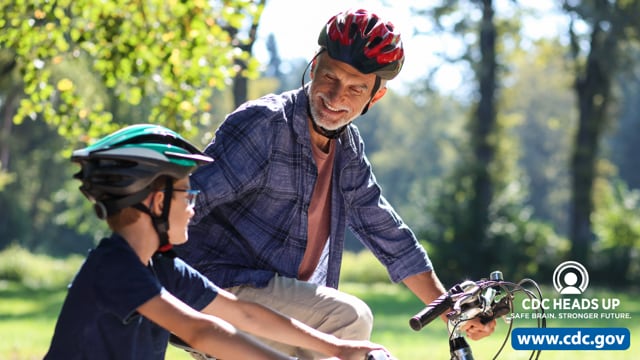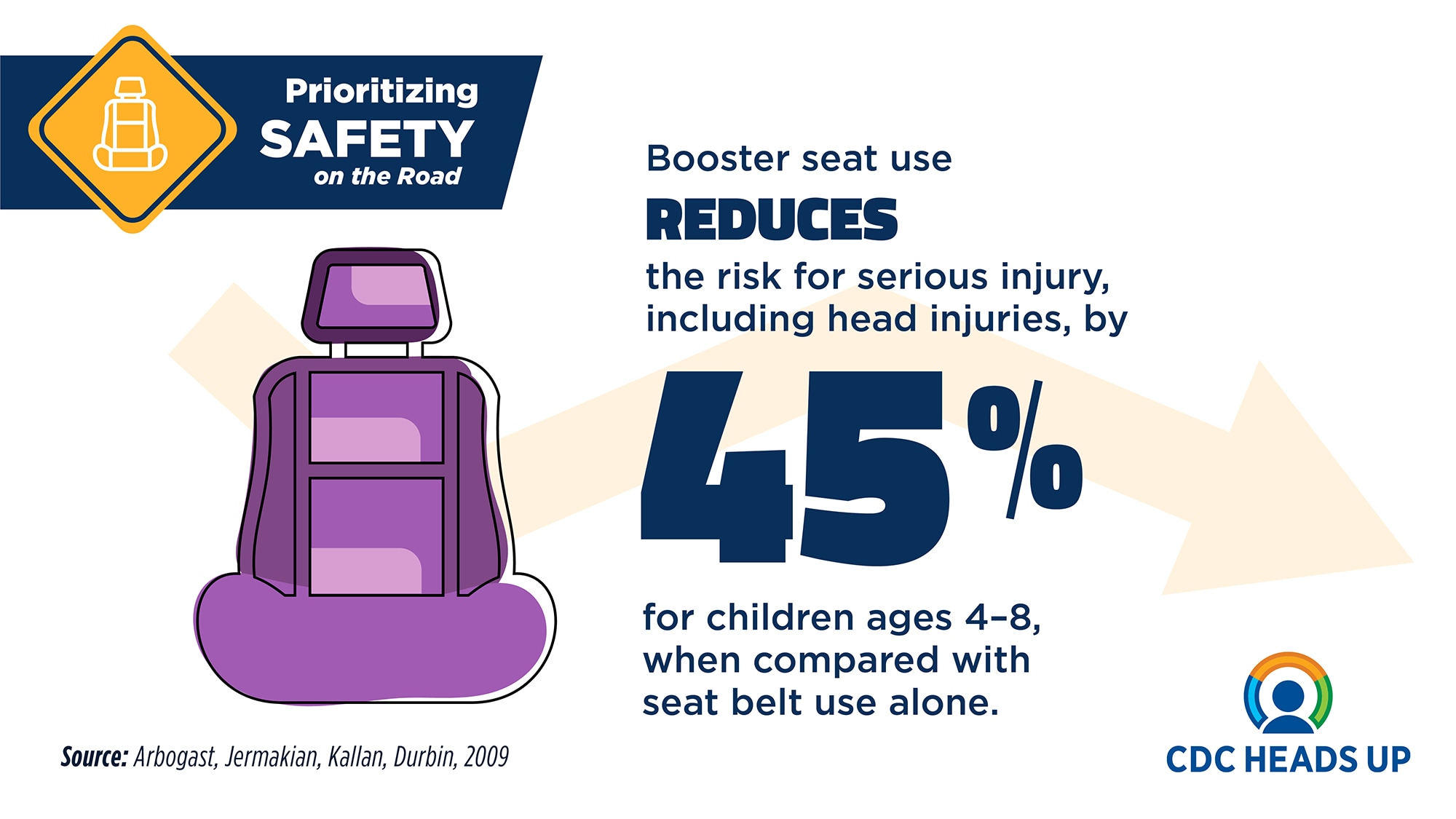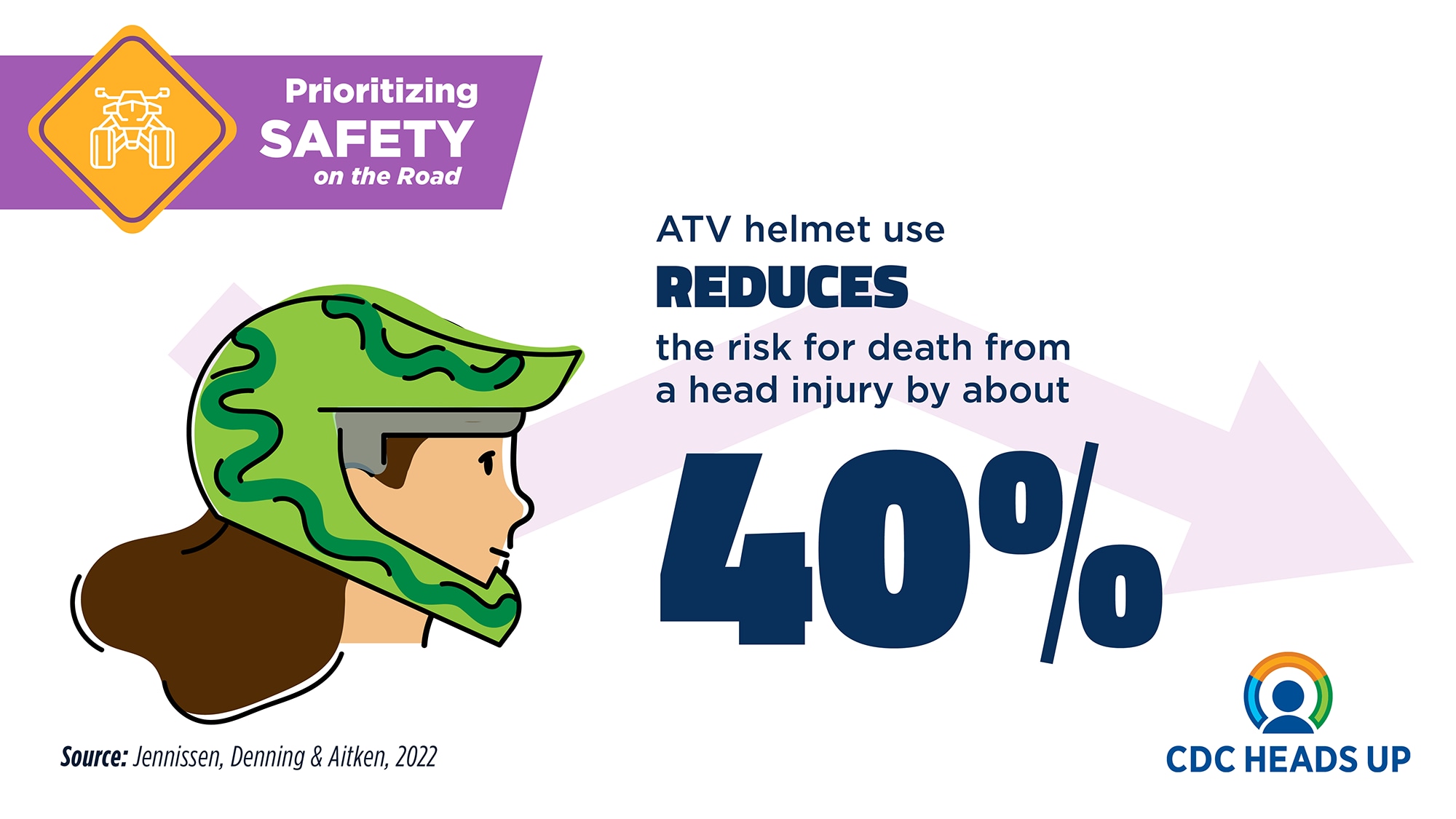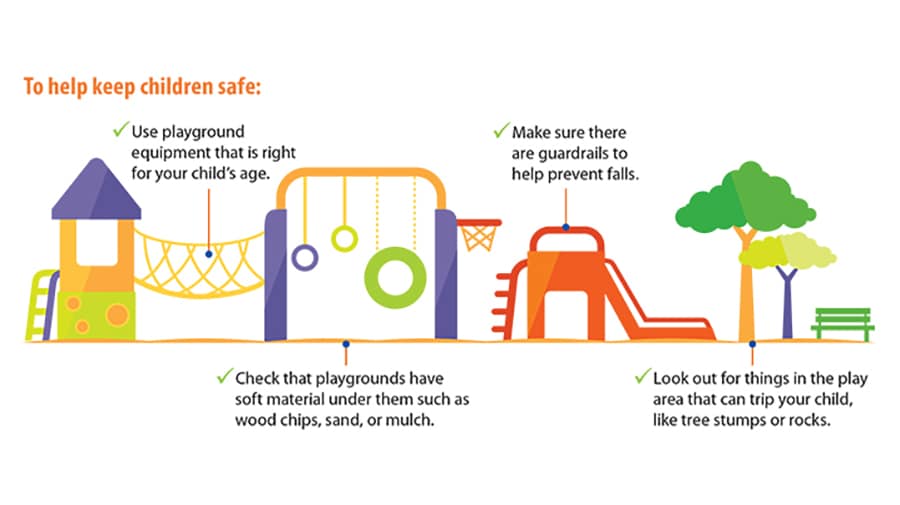Key points
- There are many ways to lower the chance that your child will get a concussion or other serious brain injury.
- Use these safety tips to protect your child from the leading causes of concussion.

Fall safety tips
Falls can occur anywhere and are the leading cause of TBI and concussions among children.12 You play a crucial role in preventing falls by using:
- Window guards or stops
- Stair gates
- Handrails
Supervision is essential around potential fall hazards, whether at home, school, or during play.2
Motor vehicle safety tips
Ensure your child is always properly buckled up in a car seat, booster seat or seat belt — whichever is appropriate for their age and size.3 Avoid reusing a car seat that shows signs of damage, has been recalled or expired, has been involved in a crash, or lacks essential information such as an expiration date, model number, or instructions.

If your child is learning to drive, stress the importance of driver safety by talking with them about the eight "danger zones."4
Helmet safety tips
Make sure your child always wears the right helmet for their activity and that it fits correctly.5 Wearing a helmet is a must to help reduce the risk of a serious brain injury or skull fracture while bicycling, skateboarding, skiing or snowboarding, riding on a scooter, and playing sports like tackle football. Replace helmets that have been damaged.5 Be cautious of helmet-related products that may overstate injury-prevention benefits, such as products claiming they can prevent all concussions.67

Recreational vehicle safety tips
Follow the latest guidance on all-terrain vehicle or ATV safety. No child younger than 16 years of age should operate or ride as a passenger on an ATV.8 Get additional information on ATV safety practices from the American Academy of Pediatrics.8

Playground safety tips
Have your child use playgrounds with soft material under them like mulch or sand, not grass or dirt.910 Read the HEADS UP Playground Safety Tips for Parents to learn more.

Specific sport recommendations
Your actions can create a safe sport culture. That can lower an athlete's chance of getting a concussion or other serious injury.
Athletes thrive when they:11
- Have fun playing their sport.
- Receive positive messages and praise from their coaches for concussion symptom reporting.
- Have parents who talk with them about concussions and model and expect safe play.
- Support their teammates sitting out of play if they have a concussion.
- Feel comfortable reporting symptoms of a possible concussion to parents and coaches.
Find data on sports- and recreation-related activities.
Sports programs can:
- Expand opportunities for youth in all communities12 to participate in low-cost13 non-contact football programs, such as flag and touch football.
- Limit the number of contact practices for contact and collision sports.141516
- Enforce the rules of the sport for fair play, safety, and sportsmanship.1517181920
- Ensure athletes avoid unsafe actions such as:12122
- Hitting another athlete in the head
- Using their head to tackle or hit another athlete
- Hitting another athlete in the head
- Educate coaches, sports officials, parents, and athletes about concussion policies and about strategies to reduce head impacts and concussions.2324
Violence prevention safety tips
Violence is a leading cause of TBIs among children.2526 Children younger than 4 years of age and those with special needs (such as disabilities, mental health issues, and chronic physical illnesses) may be at increased risk for assault and abuse.272829 Learn more about strategies to protect children from assault and other forms of violence.
- Chen C, Peng J, Sribnick EA, Zhu M, Xiang H. Trend of Age-Adjusted Rates of Pediatric Traumatic Brain Injury in U.S. Emergency Departments from 2006 to 2013. Int J Environ Res Public Health. Jun 5 2018;15(6)doi:10.3390/ijerph15061171
- Haarbauer-Krupa J, Haileyesus T, Gilchrist J, Mack KA, Law CS, Joseph A. Fall-related traumatic brain injury in children ages 0–4 years. Journal of safety research. 2019;70:127-133.
- Richard CM, Magee K, Bacon-Abdelmoteleb P, Brown JL. Countermeasures That Work: A Highway Safety Countermeasure Guide For State Highway Safety Offices Ninth Edition, 2017. 2018. https://www.nhtsa.gov/sites/nhtsa.dot.gov/files/documents/812478_countermeasures-that-work-a-highway-safety-countermeasures-guide-.pdf
- Centers for Disease Control and Prevention. Eight Danger Zones: Parents Are the Key to Safe Teen Drivers. Accessed March, 2024. https://www.cdc.gov/teen-drivers/parents-are-the-key/danger-zones.html
- US Consumer Product Safety Commission. Which Helmet for Which Activity. Accessed March, 2024. https://www.cpsc.gov/safety-education/safety-guides/sports-fitness-and-recreation-bicycles/which-helmet-which-activity
- Swartz EE, Register-Mihalik JK, Broglio SP, et al. National Athletic Trainers' Association Position Statement: Reducing Intentional Head-First Contact Behavior in American Football Players. J Athl Train. Feb 1 2022;57(2):113-124. doi:10.4085/1062-6050-0062.21
- Patricios JS, Schneider KJ, Dvorak J, et al. Consensus statement on concussion in sport: the 6th International Conference on Concussion in Sport–Amsterdam, October 2022. British Journal of Sports Medicine. 2023;57(11):695-711. doi:10.1136/bjsports-2023-106898
- Jennissen CA, Denning GM, Aitken ME, et al. American Academy of Pediatrics Recommendations for the Prevention of Pediatric ATV-Related Deaths and Injuries. Pediatrics. Oct 1 2022;150(4)doi:10.1542/peds.2022-059279
- Cheng TA, Bell JM, Haileyesus T, Gilchrist J, Sugerman DE, Coronado VG. Nonfatal Playground-Related Traumatic Brain Injuries Among Children, 2001-2013. Pediatrics. Jun 2016;137(6)doi:10.1542/peds.2015-2721
- U.S. Consumer Product Safety Commission. Public Playground Safety Handbook. Vol. 325. 2010. https://www.cpsc.gov/s3fs-public/325.pdf
- Centers for Disease Control and Prevention. HEADS UP concussion: Concussion at play. Opportunities to reshape the culture around concussion. Centers for Disease Control and Prevention. Accessed October 21, 2022, https://stacks.cdc.gov/view/cdc/32519
- Kroshus E, Sonnen AJ, Chrisman SP, Rivara FP. Association between community socioeconomic characteristics and access to youth flag football. Injury prevention : journal of the International Society for Child and Adolescent Injury Prevention. Aug 2019;25(4):278-282. doi:10.1136/injuryprev-2017-042677
- The Aspen Institute. State of Play Central Ohio. Accessed February 8, 2024. https://projectplay.org/communities/central-ohio
- Broglio SP, Williams RM, O'Connor KL, Goldstick J. Football Players' Head-Impact Exposure After Limiting of Full-Contact Practices. J Athl Train. Jul 2016;51(7):511-8. doi:10.4085/1062-6050-51.7.04
- Emery CA, Black AM, Kolstad A, et al. What strategies can be used to effectively reduce the risk of concussion in sport? A systematic review. Br J Sports Med. Jun 2017;51(12):978-984. doi:10.1136/bjsports-2016-097452
- Eliason PH, Galarneau JM, Kolstad AT, et al. Prevention strategies and modifiable risk factors for sport-related concussions and head impacts: a systematic review and meta-analysis. Br J Sports Med. Jun 2023;57(12):749-761. doi:10.1136/bjsports-2022-106656
- Graham R, Rivara FP, Ford MA, Spicer CM. Sports-related concussions in youth: improving the science, changing the culture. National Academies Press; 2014.
- Cusimano MD, Nastis S, Zuccaro L. Effectiveness of interventions to reduce aggression and injuries among ice hockey players: a systematic review. CMAJ : Canadian Medical Association journal = journal de l'Association medicale canadienne. Jan 8 2013;185(1):E57-69. doi:10.1503/cmaj.112017
- Beaudouin F, Aus der Funten K, Tross T, Reinsberger C, Meyer T. Head injuries in professional male football (soccer) over 13 years: 29% lower incidence rates after a rule change (red card). Br J Sports Med. Jun 23 2017;doi:10.1136/bjsports-2016-097217
- Obana KK, Mueller JD, Saltzman BM, et al. Targeting Rule Implementation Decreases Concussions in High School Football: A National Concussion Surveillance Study. Orthop J Sports Med. Oct 2021;9(10):23259671211031191. doi:10.1177/23259671211031191
- Champagne AA, Distefano V, Boulanger MM, et al. Data-informed Intervention Improves Football Technique and Reduces Head Impacts. Medicine and science in sports and exercise. Nov 2019;51(11):2366-2374. doi:10.1249/mss.0000000000002046
- Marks ME, Holcomb TD, Pritchard NS, et al. Characterizing Exposure to Head Acceleration Events in Youth Football Using an Instrumented Mouthpiece. Annals of biomedical engineering. Nov 2022;50(11):1620-1632. doi:10.1007/s10439-022-03097-7
- Daugherty J, DePadilla L, Sarmiento K. Assessment of HEADS UP online training as an educational intervention for sports officials/athletic trainers. Journal of Safety Research. 2020;74:133-141.
- Daugherty J, DePadilla L, Sarmiento K. Effectiveness of the US Centers for Disease Control and Prevention HEADS UP coaches' online training as an educational intervention. Health Educ J. 2019;78(7):784-797. doi:10.1177/0017896919846185
- Peterson AB, Zhou H, Thomas KE. Disparities in traumatic brain injury-related deaths-United States, 2020. Journal of Safety Research. 2022;83:419-426. doi:https://dx.doi.org/10.1016/j.jsr.2022.10.001
- Taylor CA, Bell JM, Breiding MJ, Xu L. Traumatic Brain Injury-related Emergency Department Visits, Hospitalizations, and Deaths — United States, 2007 and 2013. MMWR: Morbidity and mortality weekly report. 2017;66(9):1–16.
- Means MJ, Myers RK, Master CL, Arbogast KB, Fein JA, Corwin DJ. Assault-Related Concussion in a Pediatric Population. Pediatric Emergency Care. 2022;
- Centers for Disease Control and Prevention. Abusive Head Trauma. Accessed March, 2024. https://www.cdc.gov/child-abuse-neglect/about/about-abusive-head-trauma.html
- Centers for Disease Control and Prevention. Child Abuse and Neglect: Risk and Protective Factors. Accessed March, 2024. https://www.cdc.gov/child-abuse-neglect/risk-factors/index.html
